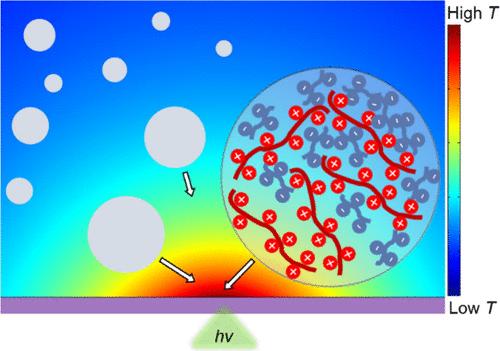热解离型凝聚态液滴的嗜热行为
IF 9.1
1区 材料科学
Q1 CHEMISTRY, MULTIDISCIPLINARY
引用次数: 0
摘要
在探索生命起源的过程中,有人提出液-液相分离的凝聚态液滴是原始的原生细胞。根据热液假说,这些液滴会从富含分子的热流体中产生,因此会受到温度梯度的影响。研究这些液滴的热泳行为可以深入了解原细胞在热景观中的足迹,从而加深我们对生命起源的理解。在这里,我们报告了热解离液滴的嗜热行为,这与热结合冷凝物更喜欢较热区域的直觉相反。这意味着热解离型原始冷凝物更倾向于在热液环境附近存在,从而促进分子掺入和生化合成。此外,我们的研究还揭示了热泳运动和电泳运动之间的相似性,这是由分子在液滴内的重新分布决定的,因为液滴具有流体性质,这就有必要修改目前用于表面电荷表征的电泳框架。我们的研究阐明了凝聚态液滴是如何在热场和电场中航行的,揭示了它们依赖于热环境的分子特征,并为早期生命的基础理论架起了桥梁:热液假说和凝聚态原电池假说。本文章由计算机程序翻译,如有差异,请以英文原文为准。

Thermophilic Behavior of Heat-Dissociative Coacervate Droplets
In exploring the genesis of life, liquid–liquid phase-separated coacervate droplets have been proposed as primitive protocells. Within the hydrothermal hypothesis, these droplets would emerge from molecule-rich hot fluids and thus be subjected to temperature gradients. Investigating their thermophoretic behavior can provide insights into protocell footprints in thermal landscapes, advancing our understanding of life’s origins. Here, we report the thermophilic behavior of heat-dissociative droplets, contrary to the intuition that heat-associative condensates would prefer hotter areas. This aspect implies the preferential presence of heat-dissociative primordial condensates near hydrothermal environments, facilitating molecular incorporation and biochemical syntheses. Additionally, our investigations reveal similarities between thermophoretic and electrophoretic motions, dictated by molecular redistribution within droplets due to their fluid nature, which necessitates revising current electrophoresis frameworks for surface charge characterization. Our study elucidates how coacervate droplets navigate thermal and electric fields, reveals their thermal-landscape-dependent molecular characteristics, and bridges foundational theories of early life: the hydrothermal and condensate-as-protocell hypotheses.
求助全文
通过发布文献求助,成功后即可免费获取论文全文。
去求助
来源期刊

Nano Letters
工程技术-材料科学:综合
CiteScore
16.80
自引率
2.80%
发文量
1182
审稿时长
1.4 months
期刊介绍:
Nano Letters serves as a dynamic platform for promptly disseminating original results in fundamental, applied, and emerging research across all facets of nanoscience and nanotechnology. A pivotal criterion for inclusion within Nano Letters is the convergence of at least two different areas or disciplines, ensuring a rich interdisciplinary scope. The journal is dedicated to fostering exploration in diverse areas, including:
- Experimental and theoretical findings on physical, chemical, and biological phenomena at the nanoscale
- Synthesis, characterization, and processing of organic, inorganic, polymer, and hybrid nanomaterials through physical, chemical, and biological methodologies
- Modeling and simulation of synthetic, assembly, and interaction processes
- Realization of integrated nanostructures and nano-engineered devices exhibiting advanced performance
- Applications of nanoscale materials in living and environmental systems
Nano Letters is committed to advancing and showcasing groundbreaking research that intersects various domains, fostering innovation and collaboration in the ever-evolving field of nanoscience and nanotechnology.
 求助内容:
求助内容: 应助结果提醒方式:
应助结果提醒方式:


